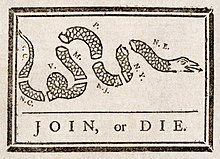
Benjamin Franklin was an American polymath who was active as a writer, scientist, inventor, statesman, diplomat, printer, publisher, and political philosopher. Among the leading intellectuals of his time, Franklin was one of the Founding Fathers of the United States, a drafter and signer of the Declaration of Independence, and the first Postmaster General.

William Bradford was an early American colonial printer and publisher in British America. Bradford is best known for establishing the first printing press in the Middle colonies of the Thirteen Colonies, founding the first press in Pennsylvania in 1685 and the first press in New York in 1693. Bradford operated continuously printing establishments for sixty-two years, heading a family that would include printers and publishers for 140 years. He was also known for controversies regarding freedom of the press. Starting his printing career in London, Bradford emigrated to America in 1685. He established, with others, the first paper mill to appear in the Thirteen American Colonies.

Andrew Bradford was an early American printer in colonial Philadelphia. He published the first newspaper in Philadelphia, The American Weekly Mercury, beginning in 1719, as well as the first magazine in America in 1741.
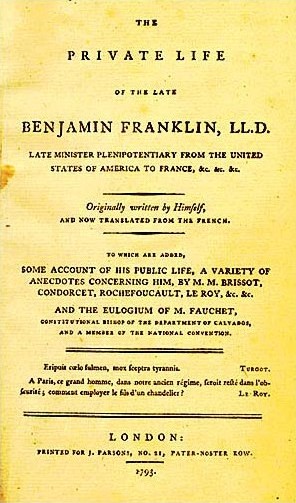
The Autobiography of Benjamin Franklin is the traditional name for the unfinished record of his own life written by Benjamin Franklin from 1771 to 1790; however, Franklin appears to have called the work his Memoirs. Although it had a tortuous publication history after Franklin's death, this work has become one of the most famous and influential examples of an autobiography ever written.

Letters from a Farmer in Pennsylvania is a series of essays written by the Pennsylvania lawyer and legislator John Dickinson (1732–1808) and published under the pseudonym "A Farmer" from 1767 to 1768. The twelve letters were widely read and reprinted throughout the Thirteen Colonies, and were important in uniting the colonists against the Townshend Acts in the run-up to the American Revolution. According to many historians, the impact of the Letters on the colonies was unmatched until the publication of Thomas Paine's Common Sense in 1776. The success of the letters earned Dickinson considerable fame.
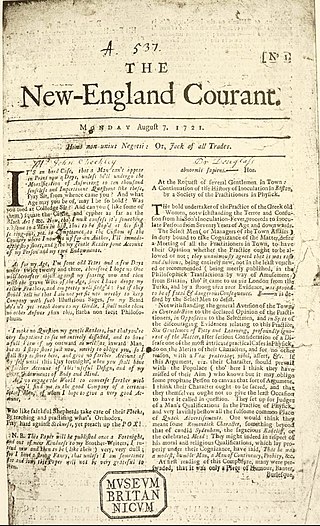
The New-England Courant, one of the first American newspapers, was founded in Boston in 1721, by James Franklin. It was a weekly newspaper and the third to appear in Boston. Unlike other newspapers, it offered a more critical account about the British colonial government and other royal figures of authority. The newspaper published critical commentary about smallpox inoculation which fueled the controversy during the smallpox epidemic in Boston. Ultimately it was suppressed in 1726 by British colonial authorities for printing what they considered seditious articles. Franklin took on his brother, Benjamin Franklin, as an apprentice and at one point was compelled to sign over publication of the Courant to him to avert further prosecution. Benjamin submitted anonymous editorials to the Courant, which resulted in James' imprisonment after he began publishing them.This sort of Governmental censorship of early colonial newspapers is what largely fostered the American ideal of Freedom of Speech in the press. The New England Courant is widely noted among historians as being the first newspaper to publish Benjamin's writings.

TheNewport Mercury, was an early American colonial newspaper founded in 1758 by Ann Smith Franklin (1696–1763), and her son, James Franklin (1730–1762), the nephew of Benjamin Franklin. The newspaper was printed on a printing press imported by Franklin's father, James Franklin (1697–1735), in 1717 from London. The Mercury may be the first newspaper published by a woman in the colonial United States. The Mercury was the also first paper to publish poetry by an African American woman, Phillis Wheatley.

William Goddard was an early American patriot, publisher, printer and postal inspector. Born in New London, Connecticut, Goddard lived through the American Revolutionary era, during which he opposed British rule of the colonies through his actions and publications. He was a major figure in the development of the colonial postal system, which became the U.S. Post Office after the American Revolution.

The Pennsylvania Chronicle and Universal Advertiser was an American colonial newspaper founded in 1767 that was published in Philadelphia, Pennsylvania, prior to the American Revolution and was founded by William Goddard and his silent business partners Joseph Galloway and Thomas Wharton. Benjamin Franklin, an associate of Galloway, was also a partner with the Chronicle.
Samuel Keimer (1689–1742) was originally an English printer and emigrant who came to America and became an Early American printer. He was the original founder of The Pennsylvania Gazette. On October 2, 1729, Benjamin Franklin bought this newspaper.

William Parks was an 18th-century printer and journalist in England and Colonial America. He was the first printer in Maryland authorized as the official printer for the colonial government. He published the first newspaper in the Southern American colonies, the Maryland Gazette. He later became authorized as the official printer for the colonial government of Virginia. Parks was also the publisher and printer of the first official collection of the authentic 1733 set of Virginia's laws, and the first colonial publisher and proprietor of The Virginia Gazette newspaper. During his lifetime Parks established four new newspapers in the colonies. He also worked with Benjamin Franklin on several projects related to printing, most notably, the establishment of a paper mill in Virginia, the first such mill south of Pennsylvania.
Hugh Meredith was a farmer and printer in the American colonies, who briefly had a partnership with Benjamin Franklin as publishers of the Pennsylvania Gazette.
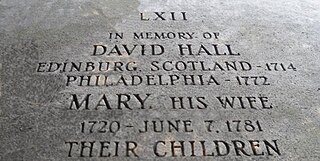
David Hall was a British printer who immigrated from Scotland to America and became an early American printer, publisher and business partner with Benjamin Franklin in Philadelphia. He eventually took over Franklin's printing business of producing official documents for the colonial province of Pennsylvania and that of publishing The Pennsylvania Gazette newspaper that Franklin had acquired in 1729. Hall formed his own printing firm in 1766 and formed partnership firms with others. He published material for the colonial government.

The Busy-Body was a pen name used by Benjamin Franklin and Joseph Breintnall in a column printed in The American Weekly Mercury, an early American newspaper founded and published by Andrew Bradford. There are 32 letters in "The Busy-Body" series. The essays were printed in 1729.

Early American publishers and printers played a central role in the social, religious, political and commercial development of the Thirteen Colonies in British America prior to and during the American Revolution and the ensuing American Revolutionary War that established American independence.
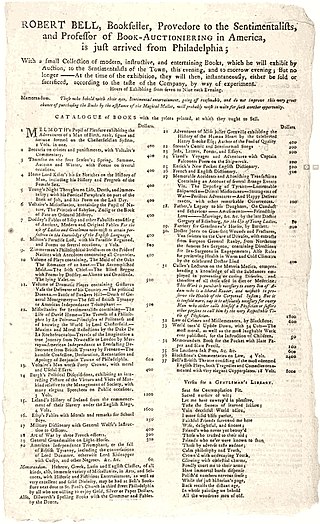
Robert Bell (1732–1784) was a Scottish immigrant to the British colonies in America and became one of many early American printers and publishers active during the years leading up to and through the American Revolution. Bell became widely noted for printing Thomas Paine's celebrated work, Common Sense, a highly influential work during the revolution that openly criticized the British Parliament and their management and taxation of the British-American colonies. Bell and Paine later had a falling out over profits and publication issues. As a dedicated patriot, Bell printed many pamphlets and books before and during the revolution, many of which "glowingly" expressed his patriotic views. He also reprinted a number of popular English works, presenting them to the colonies for the first time. He ran an auction house which sold rare books in Lancaster, and in later life he toured the colonies selling off his massive book collection. After Bell's death, his printing press and other items were sold at a Philadelphia auction house to another prominent printer at an unusually high price.

Bibliography of early American publishers and printers is a selection of books, journals and other publications devoted to these topics covering their careers and other activities before, during and just after the American Revolution. Various works that are not primarily devoted to those topics, but whose content devotes itself to them in significant measure, are sometimes included here also. Works about Benjamin Franklin, a famous printer and publisher, among other things, are too numerous to list in this bibliography, can be found at Bibliography of Benjamin Franklin, and are generally not included here unless they are greatly devoted to Franklin's printing career. Single accounts of printers and publishers that occur in encyclopedia articles are neither included here.

The Papers of Benjamin Franklin is a collaborative effort by a team of scholars at Yale University, American Philosophical Society and others who have searched, collected, edited, and published the numerous letters from and to Benjamin Franklin, and other works, especially those involved with the American Revolutionary period and thereafter. The publication of Franklin's papers has been an ongoing production since its first issue in 1959, and is expected to reach nearly fifty volumes, with more than forty volumes completed as of 2022. The costly project was made possible from donations by the American Philosophical Association and Life magazine.

The Bibliography of Benjamin Franklin is a comprehensive list of primary and secondary works by or about Benjamin Franklin, one of the principal Founding Fathers of the United States. Works about Franklin have been consistently published during and after Franklin's life, spanning four centuries, and continue to appear in present-day publications. Scholarly works that are not necessarily subject-specific to Franklin, yet cover his life and efforts in significant measure, may also be included here, while the numerous encyclopedia articles and short essays about Franklin are not included in this bibliography.


